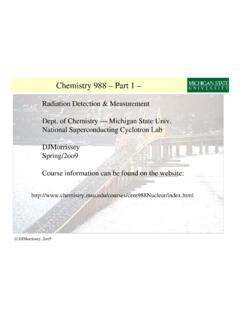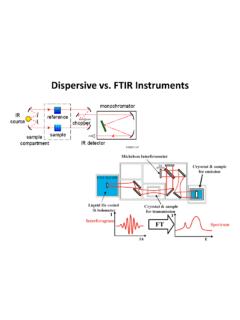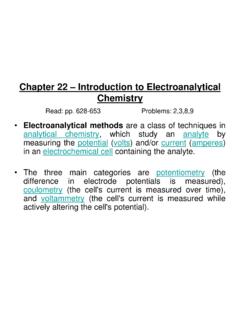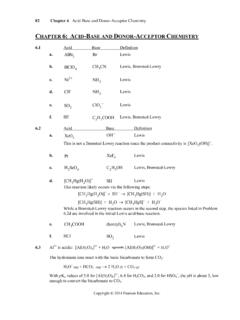Transcription of Chapter 24 Chemistry of Coordination Compounds
1 Chapter 24! Chemistry of Coordination Compounds ! Coordination Compounds ! How do we think about transition metals binding to other atoms? What do those d orbitals do? We call them, Coordination Compounds . Complexes! A central metal atom can bond to a group of molecules or ions: metal complex. If it s charged: complex ion. Compounds containing complexes are Coordination Compounds . Question, is this an ionic compound Does it dissociate in water? Complexes! The molecules or ions coordinating to the metal are the ligands. They are usually anions or polar molecules. They must have lone pairs to interact with metal Ligands Complexes! Examples of some common ligands Note, all have lone pairs Some are charged, others are not. A chemical mystery: Same metal, same ligands, different number of ions when dissolved Many Coordination Compounds are brightly colored, but again, same metal, same ligands, different colors.
2 Werner s Theory! suggested in 1893 that metal ions have primary and secondary valences. Primary valence equals the metal s oxidation number Secondary valence is the number of atoms directly bonded to the metal ( Coordination number) Co(III) oxidation state Coordination # is 6 Cl- Werner s Theory! The central metal and the ligands directly bonded to it make up the Coordination sphere of the complex. In CoCl3 6 NH3, all six of the ligands are NH3 and the 3 chloride ions are outside the Coordination sphere. Werner s Theory In CoCl3 5 NH3 the five NH3 groups and one chlorine are bonded to the cobalt, and the other two chloride ions are outside the sphere. Werner s Theory Werner proposed putting all molecules and ions within the sphere in brackets and those free anions (that dissociate from the complex ion when dissolved in water) outside the brackets.
3 Werner s Theory! This approach correctly predicts there would be two forms of CoCl3 4 NH3. The formula would be written [Co(NH3)4Cl2]Cl. One of the two forms has the two chlorines next to each other. The other has the chlorines opposite each other. Oxidation Numbers Knowing the charge on a complex ion and the charge on each ligand, one can determine the oxidation number for the metal. Oxidation Numbers Or, knowing the oxidation number on the metal and the charges on the ligands, one can calculate the charge on the complex ion. Example: Cr(III)(H2O)4Cl2 + What is Coordination ?! When an orbital from a ligand with lone pairs in it overlaps with an empty orbital from a metal M L So ligands must have lone pairs of electrons. Sometimes called a coordinate covalent bond Metal d orbital Metal-Ligand Bond! This bond is formed between a Lewis acid and a Lewis base.
4 The ligands (Lewis bases) have nonbonding electrons. The metal (Lewis acid) has empty orbitals. What is Coordination ?! There are 3 ways of looking at bonding in Coordination Compounds : Valence bond theory Ligand Field Theory (adaptation of MO theory) Crystal Field Theory (theory of pure electrostatic interactions So ligands must have lone pairs of electrons. Valence Bond theory Just like we learned before. We mix the atomic orbitals on the metal before we bond the ligands: For Transition metals we have 9-14 valence orbitals 1 ns 5 (n-1)d 3 np 5 nd Valence Bond theory Just like we learned before. We mix the atomic orbitals on the metal before we bond the ligands: For Transition metals we have 14 valence orbitals 1 ns 5 (n-1)d 3 np 5 nd if needed. Valence Bond theory Example Co(NH3)63+ Co3+ electron configuration: 4s23d4 ---- 4s03d6 Need six orbitals for six ligands so: Hybridize 1 4s, 3 4p and 2 3d to give: Sp3d2 orbitals.)
5 The 6 electrons of Co+3 sit in the other 3 d orbitals. Valence Bond theory Example Ni(NH3)62+ Ni2+ electron configuration (8 electrons): 4s23d6 ---- 4s03d8 Need six orbitals for six ligands but: 4 3d orbitals are full, only 1 3d orbital left Must hybridize 1 4s, 3 4p and 2 4d to give: sp3d2 orbitals. The 8 electrons of Ni2+ sit in five 3d orbitals. Ligand Field theory (MO theory for Coordination Compounds ) 3d 4s 4p Ti(NH3)3+ Metal-Ligand Bond The metal s Coordination ligands and geometry can greatly alter its properties, such as color, or ease of oxidation. Coordination Number! The atom that supplies the lone pairs of electrons for the metal-ligand bond is the donor atom. The number of these atoms is the Coordination number. Coordination Number! Some metals, such as chromium(III) and cobalt(III), consistently have the same Coordination number (6 in the case of these two metals).
6 The most commonly encountered numbers are 4 and 6. Geometries! Metal ions with d8 configuration are often 4 coordinate There are two common geometries for metals with a Coordination number of four: Tetrahedral Square planar Tetrahedral Square planar Why square planar? We ll get to that Geometries! By far the most-encountered geometry, when the Coordination number is six, is octahedral. Polydentate Ligands! Some ligands have two or more donor atoms. These are called polydentate ligands or chelating agents. In ethylenediamine, NH2CH2CH2NH2, represented here as en, each N is a donor atom. Therefore, en is bidentate. Polydentate Ligands! Ethylenediaminetetraacetate, mercifully abbreviated EDTA, has six donor atoms. Wraps around the central atom like an octopus Polydentate Ligands! Chelating agents generally form more stable complexes than do monodentate ligands.
7 Chelating Agents Bind to metal ions removing them from solution. Phosphates are used to tie up Ca2+ and Mg2+ in hard water to prevent them from interfering with detergents. 5- - - - - - .. : : : : : : : : .. Chelating Agents Porphyrins are complexes containing a form of the porphine molecule shown at right. Important biomolecules like heme and chlorophyll are porphyrins. Chelating Agents Porphines (like chlorophyll a) are tetradentate ligands. Porphyrin Heme binds the oxygen in your blood Part of Hemoglobin molecule Hemoglobin tetramer has 4 hemes Oxygen binding causes conformational change Makes the other sites bind oxygen better Nomenclature of Coordination Compounds Coordination complex nomenclature: name the ligands as prefixes before the metal name. Nomenclature of Coordination Compounds Cation appears first (as always) Anion is named last.
8 Ligands are listed alphabetically before the metal. Prefixes ignored when alphabetizing. Nomenclature of Coordination Compounds Anionic ligands end in o ; neutral ligands are not changed. Prefixes = number of each ligand. If the name of the ligand itself has such a prefix, alternatives like bis-, tris-, etc., are used. If complex is anion, its ending is changed to -ate. The oxidation number of the metal is given by a Roman numeral in parentheses after the metal. Nomenclature of Coordination Compounds Isomers Isomers have the same molecular formula, but either: Their bonding is different (structural isomers) or Their spatial arrangement is different (stereoisomers). Structural Isomers If a ligand (like the NO2 group at the bottom of the complex) has more than one donor atom (atom with lone pairs) as the donor atom, linkage isomers are formed.
9 Is this a structural or geometric isomer? Structural Isomers If a ligand (like the NO2 group at the bottom of the complex) can bind to the metal with one or another atom as the donor atom, linkage isomers are formed. Is this a structural or geometric isomer? Structural, bonding different Structural Isomers Some isomers differ in what ligands are bonded to the metal ( Coordination sphere) and which are not. these are Coordination -sphere isomers. Example: Three isomers of CrCl3(H2O)6 are The violet [Cr(H2O)6]Cl3, The green [Cr(H2O)5Cl]Cl2 H2O, and The (also) green [Cr(H2O)4Cl2]Cl 2 H2O. Geometric isomers Pt(NH3)2Cl2 Has two geometric isomers, two chlorines and two NH3 groups are bonded to the platinum metal, but are clearly different. cis-Isomers have like groups on the same side. trans-Isomers have like groups on opposite sides.
10 # of each atom the same Bonding the same Arrangement in space different Geometric isomers This compound binds DNA Kills rapidly dividing cancer cells This one doesn t Stereoisomers Other stereoisomers, called optical isomers or enantiomers, are mirror images of each other. Just as a right hand will not fit into a left glove, two enantiomers cannot be superimposed on each other. Enantiomers A molecule or ion that exists as a pair of enantiomers is said to be chiral. Enantiomers Physical properties of chiral molecules are identical (boiling point, freezing point, density, etc.) One exception: interaction of a chiral molecule with plane-polarized light. Enantiomers A chiral compound will rotate plane polarized light. If one enantiomer rotates the light 32 to the right, the other will rotate it 32 to the left. Generally, only when 2 chiral things interact is there a difference in properties.

















